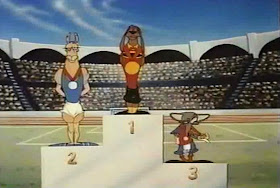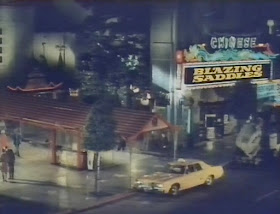By Michael Lyons
Like all else in the world, this summer's Olympics are much different than they've been in the past.
However, one thing is the same, and that is the Olympic spirit is much needed right now.
As we celebrate the games this summer, it's fun to look back at how the Olympics have also been celebrated through the years in, of all places, cartoons. Here, through exaggerated exploits, some anthropomorphic athletes have gone for the gold.
Laff-A-Lympics (1977)
Originally airing on ABC, as part of the two-hour Saturday morning show, Scooby's All-Star Laff-A-Lympics, this Hanna-Barbera series brought together almost every one of the studio's characters created up to that point in a shared universe, where they all competed in Olympic-style games.
The teams were the "Yogi Yahooeys," comprised of classic Hanna-Barbera characters, such as Yogi Bear, Boo-Boo, Huckleberry Hound, Quick Draw McGraw, and Wally Gator, just to name a few; the "Scoobie Doobies" were comprised of (then) newer HB stars such as Scooby-Doo, Shaggy, Dynomutt and Captain Caveman; and then there were the villainous "Really Rottens," led by Mumbley (who had been a "good guy" detective in an earlier series, but let's not try to unravel "HB logic") and included a number of the studio's most infamous characters such as the Dread Baron, the Great Fondoo and Daisy Mayhem.
Snagglepuss and Mildew Wolf would serve as the announcers for each episode, which would have very similar plots: the teams would travel the world, compete in various sporting events, and the Really Rottens would attempt to win by cheating.
Amidst the messages of sportsman-like conduct and the downfalls of not playing by the rules, the true Saturday morning magic of this show for a generation of kids was in watching so many comforting, familiar cartoon faces in the same space competing against each other.
Hong Kong Phooey pitching to Quick Draw McGraw in a baseball game or the Blue Falcon uncovering the Really Rottens’ cheating during a pole vaulting event is, to many animation fans, as amazing as an opening ceremony.
Animalympics (1980)
This seldom-seen animated feature is unique in so many ways. It shows the "broadcast" of the Olympic Games (both summer and winter) in the animal world, with very creative touches. A dragon lights the torch; a gazelle and cheetah compete in track and field; whales, squid, and manta rays take part in the swim meet, and a minx takes on gymnastics. All of this is broadcast on the "ZOO" network.
The animation in Animalympics is fuller than other television animation from the time, and the character designs of the anthropomorphic animals are so much fun to watch. Coupled with this is a sharply written script that satires everything from politics to broadcast journalism.
This comes as no surprise when one learns of the talent involved with Animalympics. Voices are provided by Harry Shearer (before his Simpsons days), Gilda Radner (during the height of her SNL popularity), and Billy Crystal (as his star was beginning to ascend thanks to the TV sitcom Soap).
Additionally, at the helm of directing was Steve Lisberger, who would bring the world Tron just two years later. Animators who worked on the film were also talents about to rise, among them Roger Allers (who would co-direct The Lion King) and Brad Bird (The Incredibles).
Unfortunately, Animalympics never received the audience it deserved. It was to be produced as a two-part special for NBC. The first part, the Winter Games, aired in early 1980, but when the United States decided to boycott the Summer Olympics in Moscow that year, NBC canceled their TV coverage, and the second part (the Summer Games) of Animalympics.
The two specials were paired together as a feature film but never really received a significant release. Forty-one years later, Animalympics deserves a revisit, especially during this Olympic summer.
The Olympic Champ (1942)
Goofy has shown audiences his athletic side quite a bit in his series of pseudo "how-to" films, like The Art of Skiing (1941), How to Fish (1942), and Hockey Homicide (1945), why not add the Olympics to that?
In this classic Disney short subject, Goofy takes on several aspects of the Olympic games, from carrying the torch (which burns down to a small crisp) to track and field (which results in a hysterical, domino effect of collapsed hurdles he has attempted to jump).
Directing The Olympic Champ is the legendary Jack Kinney, who directed 39 similar Goofy cartoons, where the main character demonstrates his "expertise" on a subject. Kinney's skill was how to create cartoon acrobatics that seemed to go on forever (here, Goofy winds up being pursued by the pole he is using for pole vaulting!).
Adding to the fun is narrator John McLeish, who provided commentary in a very strait-laced style, which humorously offsets the disasters happening on screen.
The Olympic Champ, like Animalyimpics and Laff-A-Lympics, amid their surrealistic silliness, are all also celebrations of the Olympic games and all they represent in terms of competition, perseverance, sportsmanship, teamwork, inspiration, and collaboration.
Here's to the Olympic Games!















